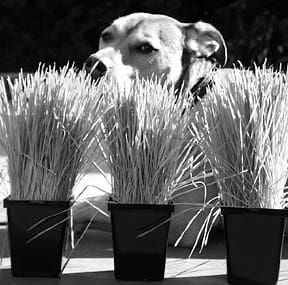A reader asks, Why does my dog eat grass? It makes him throw up. I’d like to train him not to do this, but I’m not sure how.
Dogs have been eating grass for so long that one species is called dog grass in their honor. Dog grass or couch grass (Agropyron repens), which is also called quackweed, grows in all but our southernmost states, and it is most commonly found in the upper Midwest.
The worlds most experienced canine herbalist was Juliette de Bairacli Levy, whose Complete Herbal Handbook for the Dog and Cat was published in 1955. In its sixth edition (1992, Faber & Faber, London), she wrote, ”The favorite dog medicine, also much eaten by cats, is dog grass or couch grass. Of this herb they eat the leaves and the root, which they either vomit up, with much yellow bile fluid, or excrete. It is a cleanser of the bowels and removes worms. When my dogs cannot get couch grass, they will utilize other grasses, but do so with reluctance. Their next choice after couch grass seems to be wild oats.”
Preventing dogs from eating grass is a serious mistake, she warns, noting that dogs bring on deliberate internal cleansing by eating things that help them expel excess bile, mucus, and other impurities.
Feeding clean greens
At the same time, dogs fed grass on a regular basis don’t seem to crave outdoor grass the way they do if grass isn’t part of their diet.
”I know a man who raised barley sprouts commercially for horses,” wrote wheatgrass pioneer Ann Wigmore in Our Precious Pets (National Humane League, 1987). ”He had great success with restoring fertility to impotent studs. A friend thought that if these sprouts were so great with horses, they might also be great with dogs. He fed them to dogs with wonderful success. I would suggest either rye or barley sprouts for dogs and cats. These sprouts should be better for animals than wheat sprouts. They would serve as a good supplement to commercial pet foods.”
To grow rye or barley grass for pets, soak one cup organically grown grain in one quart water for 8 to 10 hours or overnight. Drain the jar and leave it on its side in a warm location, away from direct sunlight. After 24 to 48 hours, a tiny white rootlet will emerge from each grain. If you don’t see this growth, your grain is not viable and should be discarded. Irradiated grain won’t sprout, and neither will grain that has been improperly stored.
To grow grass, spread the sprouting grain on one inch of moist potting soil or top soil in a plastic garden tray. For best results, create a one-inch channel around the soil for drainage.
Cover the tray for two days, then uncover, water it thoroughly and place it in direct sunlight or under grow lights. Water as needed to keep the soil moist.
Begin harvesting the grass with scissors or a sharp knife when it is six to eight inches tall. Cereal grasses keep well in the refrigerator if stored with a damp paper towel in plastic zipper bags from which the air is expelled prior to sealing.
Cut or mince the grass into tiny pieces, or place a small amount in a blender or food processor with other foods.
Begin by feeding a small amount, as little as a fraction of a teaspoon, to be sure your dog will accept the grass. Gradually increase the amount to about one tablespoon per 50 pounds of body weight.
Cereal grasses are rich in chlorophyll, vitamins, minerals, enzymes, and amino acids. Before fast-acting antibiotics were developed, chlorophyll was the drug of choice for preventing infection, curing ulcers, relieving pain, and treating skin diseases and anemia.
Ann Wigmore described how wheat grass and other cereal grasses improved the health and growth of her guinea pigs, parakeets, turkeys, chickens, dogs, cats, monkey, raccoon, and skunk, and she published letters from people who gave grass to their pets to prevent or treat cataracts, fleas, tumors, excessive shedding, diarrhea, anemia, and other illnesses.
Theres probably no humane way to train a dog not to seek something its body needs, so the best strategy here may be to add grass to your dogs dinner and respect his practice of herbal medicine.






